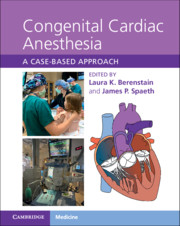Book contents
- Congenital Cardiac Anesthesia
- Congenital Cardiac Anesthesia
- Copyright page
- Dedication
- Contents
- Contributors
- Introduction
- Chapter 1 A Congenital Heart Disease Primer
- Section 1 Left-to-Right Shunts
- Section 2 Right-Sided Obstructive Lesions
- Section 3 Left-Sided Obstructive Lesions
- Chapter 14 Critical Aortic Stenosis
- Chapter 15 Aortic Stenosis
- Chapter 16 Subvalvular Aortic Stenosis
- Chapter 17 Supravalvular Aortic Stenosis
- Chapter 18 Hypertrophic Cardiomyopathy
- Chapter 19 Coarctation of the Aorta
- Chapter 20 Shone Complex
- Section 4 Complex Mixing Lesions
- Section 5 Single-Ventricle Physiology
- Section 6 Heart Failure, Mechanical Circulatory Support, and Transplantation
- Section 7 Miscellaneous Lesions and Syndromes
- Index
- References
Chapter 14 - Critical Aortic Stenosis
from Section 3 - Left-Sided Obstructive Lesions
Published online by Cambridge University Press: 09 September 2021
- Congenital Cardiac Anesthesia
- Congenital Cardiac Anesthesia
- Copyright page
- Dedication
- Contents
- Contributors
- Introduction
- Chapter 1 A Congenital Heart Disease Primer
- Section 1 Left-to-Right Shunts
- Section 2 Right-Sided Obstructive Lesions
- Section 3 Left-Sided Obstructive Lesions
- Chapter 14 Critical Aortic Stenosis
- Chapter 15 Aortic Stenosis
- Chapter 16 Subvalvular Aortic Stenosis
- Chapter 17 Supravalvular Aortic Stenosis
- Chapter 18 Hypertrophic Cardiomyopathy
- Chapter 19 Coarctation of the Aorta
- Chapter 20 Shone Complex
- Section 4 Complex Mixing Lesions
- Section 5 Single-Ventricle Physiology
- Section 6 Heart Failure, Mechanical Circulatory Support, and Transplantation
- Section 7 Miscellaneous Lesions and Syndromes
- Index
- References
Summary
Critical aortic stenosis is defined as the presence of severe aortic valve stenosis with systemic perfusion that is dependent on right ventricular output through a patent ductus arteriosus. Critical aortic stenosis is not defined by an absolute valve area or gradient because in patients with ventricular dysfunction (either systolic or diastolic) it may exist with larger valve areas and gradients may be underestimated. The degree of left ventricular hypertrophy in these neonates, though not as severe as in older patients, still exists, and the ventricle may be dilated and poorly contractile. This chapter discusses available interventions for the neonate with critical aortic stenosis: surgical aortic valvotomy vs. balloon aortic valvuloplasty in the cardiac catheterization laboratory. Preparation for care of the critically ill neonate in the cardiac catheterization laboratory is outlined, as well as perioperative and anesthetic management considerations for a neonate with critical aortic stenosis.
- Type
- Chapter
- Information
- Congenital Cardiac AnesthesiaA Case-based Approach, pp. 83 - 89Publisher: Cambridge University PressPrint publication year: 2021



